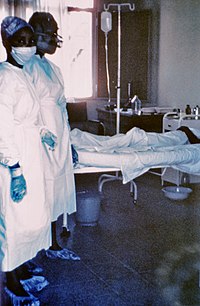
Photo from wikipedia
BACKGROUND The rising number of novel pathogens threatening the human population has motivated the application of mathematical modeling for forecasting the trajectory and size of epidemics. MATERIALS AND METHODS We… Click to show full abstract
BACKGROUND The rising number of novel pathogens threatening the human population has motivated the application of mathematical modeling for forecasting the trajectory and size of epidemics. MATERIALS AND METHODS We summarize the real-time forecasting results of the logistic equation during the 2015 Ebola challenge focused on predicting synthetic data derived from a detailed individual-based model of Ebola transmission dynamics and control. We also carry out a post-challenge comparison of two simple phenomenological models. In particular, we systematically compare the logistic growth model and a recently introduced generalized Richards model (GRM) that captures a range of early epidemic growth profiles ranging from sub-exponential to exponential growth. Specifically, we assess the performance of each model for estimating the reproduction number, generate short-term forecasts of the epidemic trajectory, and predict the final epidemic size. RESULTS During the challenge the logistic equation consistently underestimated the final epidemic size, peak timing and the number of cases at peak timing with an average mean absolute percentage error (MAPE) of 0.49, 0.36 and 0.40, respectively. Post-challenge, the GRM which has the flexibility to reproduce a range of epidemic growth profiles ranging from early sub-exponential to exponential growth dynamics outperformed the logistic growth model in ascertaining the final epidemic size as more incidence data was made available, while the logistic model underestimated the final epidemic even with an increasing amount of data of the evolving epidemic. Incidence forecasts provided by the generalized Richards model performed better across all scenarios and time points than the logistic growth model with mean RMS decreasing from 78.00 (logistic) to 60.80 (GRM). Both models provided reasonable predictions of the effective reproduction number, but the GRM slightly outperformed the logistic growth model with a MAPE of 0.08 compared to 0.10, averaged across all scenarios and time points. CONCLUSIONS Our findings further support the consideration of transmission models that incorporate flexible early epidemic growth profiles in the forecasting toolkit. Such models are particularly useful for quickly evaluating a developing infectious disease outbreak using only case incidence time series of the early phase of an infectious disease outbreak.
Journal Title: Epidemics
Year Published: 2018
Link to full text (if available)
Share on Social Media: Sign Up to like & get
recommendations!